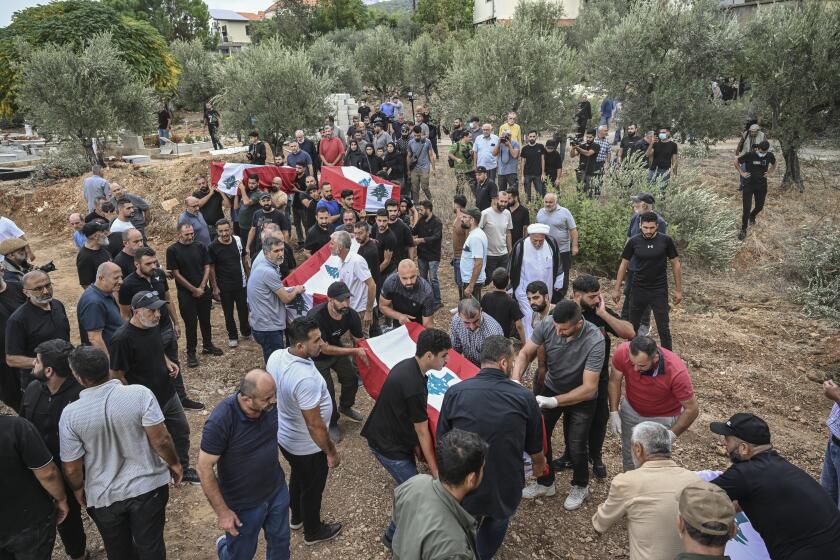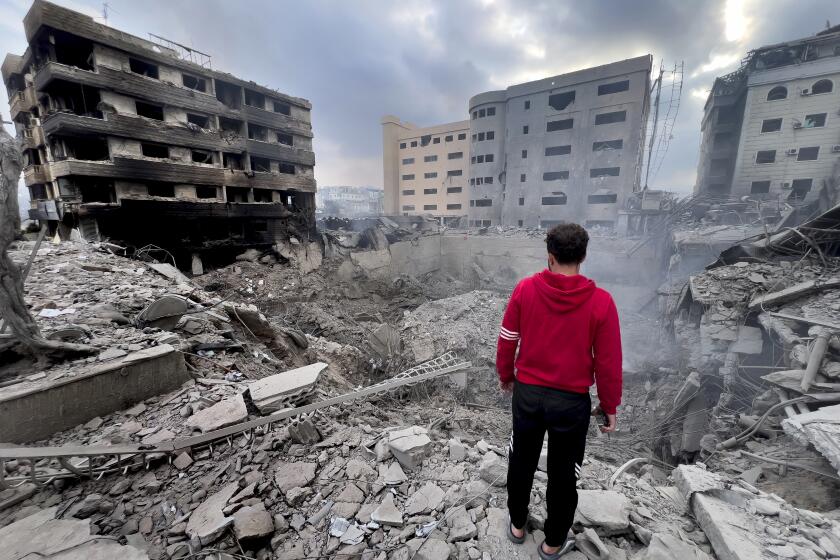Israel pummels Lebanon, Gaza, killing dozens in latest waves of airstrikes

- Share via
BEIRUT — Israel launched waves of deadly airstrikes across Lebanon’s northeast that killed at least 45 people on Friday, authorities said, and transformed once-bustling neighborhood blocks in Beirut’s southern suburbs into smoldering ruins.
Meanwhile in central Gaza, Palestinians recovered the bodies of 25 people killed in a barrage of Israeli aerial attacks that began Thursday, hospital officials said. Israel said it targeted Hamas infrastructure near the Nuseirat refugee camp.
The latest violence comes against the backdrop of the Biden administration’s renewed diplomatic push, days before the U.S. election, to reach temporary cease-fire deals. Israel has stepped up its offensive against Hamas’ remaining fighters in Gaza, pulverizing areas in the north and raising fears of worsening humanitarian conditions for civilians still there.
Israel has broadened its strikes in Lebanon to bigger urban hubs, like Baalbek, in recent weeks after initially targeting smaller border villages in the south, where Hezbollah draws deep support. The Iran-backed militant group doubles as a major political party and provider of social services in Lebanon.
Hezbollah began firing rockets, drones and missiles from Lebanon into Israel in solidarity with Hamas immediately after the Hamas-led Oct. 7, 2023, attack on Israel, which triggered the war in Gaza. The cross-border fighting boiled over to full-blown war on Oct. 1, when Israeli forces launched a ground invasion of southern Lebanon for the first time since 2006.
In Lebanon’s northeast — where small farming villages nestled between mountain ranges had largely been spared the worst of Israeli bombardment until last month — Israel conducted a series of heavy airstrikes Friday, killing at least 45 people, driving more families to flee with whatever they could carry and sending thick plumes of smoke over the horizon.
As Israeli airstrikes flatten swaths of Lebanon, groups warn the attacks mirror some of the patterns of destruction and displacement seen in Gaza.
Intensified Israeli airstrikes on and around the northeastern city of Baalbek this week have prompted 60,000 people to flee their homes, emptying many small villages in the area, said Hussein Haj Hassan, a Lebanese lawmaker representing the region.
Rescuers searched for survivors after airstrikes killed seven people in Younine, a town in the Bekaa Valley, said Gov. Bachir Khodr, and brought down a building believed to be housing 20 people. Further Israeli strikes in the northeast killed 11 people in the village of Amhaz, five people in the town of Nahleh and 14 others across the Bekaa Valley, Khodr added.
Lebanon’s state-run National News Agency also reported four others killed in the small village of Ollak, bringing the death toll from Friday’s attacks on the Bekaa Valley to 45. There was no immediate comment from Israel on the strikes.
In Lebanon’s capital, Israeli planes also pounded the Dahieh, Beirut’s southern suburbs, overnight and early Friday. The Israeli military, which warned residents to evacuate at least nine locations in the Dahieh, said it hit Hezbollah weapons manufacturing sites and command centers. There were no reports of casualties from the suburbs.
Formerly home to families and businesses, mid-rise apartment blocks were left open to the breeze, walls blown off and furniture buried. Hezbollah supporters in several locations raised the group’s bright yellow banner atop the rubble.
Since the conflict between Israel and Hezbollah erupted last year, more than 2,897 people have been killed and 13,150 wounded in Lebanon, the Health Ministry reports, not including Friday’s toll. Health authorities say that a quarter of those killed were women and children.
U.N. agencies estimate that Israel’s ground invasion and bombardment of Lebanon has displaced 1.4 million people.
Hezbollah has continued firing rockets into northern Israel, with projectiles launched from Lebanon on Thursday crashing into agricultural areas and killing seven people, including four Thai farmworkers.
Israel also continued bombarding Gaza on Friday. A barrage of airstrikes hit central Gaza’s Nuseirat refugee camp and killed at least 21 Palestinians — including an 18-month-old and his 10-year-old sister — according to health officials at nearby Al Aqsa Martyrs Hospital.
Israeli strikes also hit a motorcycle in Zuwaida and a house in Deir al Balah, killing four more people, hospital officials said, bringing the overall death toll in Gaza to 25 on Friday.
As Israel expands its strikes far from Hezbollah’s bastions into areas where displaced Shiites have fled, fears rise about worsening sectarian tensions.
The Israeli military did not comment on the strikes outside Nuseirat camp. It said it was aware of reports of civilian casualties and was investigating.
In a separate announcement, the army said an airstrike on a vehicle in Gaza’s southern town of Khan Yunis killed a senior member of the Hamas political bureau, Izz al-Din Kassab, and his assistant. Hamas confirmed Kassab’s death. Israel alleged he was a coordinator between militant groups in Gaza.
As U.S. diplomats left the region this week after meetings with Israeli officials, there were no signs of a breakthrough on a cease-fire in Lebanon or Gaza.
Hamas on Friday doubled down on its long-standing demands for a permanent cease-fire and complete Israeli withdrawal from Gaza, saying Israel offered only a temporary pause in the war and an increase in aid shipments in the latest negotiations. There was no immediate comment from Israel.
Hezbollah has been seriously weakened militarily in recent weeks, with many of its top leaders killed, and at least some of its arsenal destroyed.
“The proposals do not meet the comprehensive needs of the Palestinian people in terms of security, stability, relief, and reconstruction,” said senior Hamas official Bassem Naem, speaking first to the Hamas-run Al Aqsa TV before confirming the group’s position to the Associated Press.
Israel’s war in Gaza has killed more than 43,000 Palestinians since Oct. 7, 2023, when Hamas militants killed roughly 1,200 people in Israel and took some 250 hostages back to Gaza. Health officials inside Hamas-run Gaza do not distinguish between civilians and combatants, but say more than half of the dead in the enclave are women and children.
Hezbollah critics and supporters alike are voicing frustration over what many view as the group’s miscalculations.
Israeli forces have recently shifted their attention to Hamas militants that they say have regrouped in northern Gaza, renewing an offensive that has trapped tens of thousands of people under intense bombardment without enough food or water.
Israeli airstrikes have repeatedly delayed an emergency polio vaccination campaign, which the World Health Organization announced it planned to finally launch on Saturday — but only in Gaza City. Towns farther north including Jabaliya, Beit Lahiya and Beit Hanoun remain inaccessible as Israel tightens its siege.
The U.N. and other humanitarian organizations warned Friday that “the situation unfolding in north Gaza is apocalyptic,” citing Israel’s denial of humanitarian aid to the area, military raids on hospitals, airstrikes on shelters and obstruction of Palestinian rescue teams.
Associated Press writers Abou Aljoud reported from Beirut and Shurafa from Deir al Balah. AP writers Julia Frankel in Jerusalem. Bassem Mroue in Beirut, David Rising in Bangkok and Jamey Keaten in Geneva contributed to this report.
More to Read
Sign up for Essential California
The most important California stories and recommendations in your inbox every morning.
You may occasionally receive promotional content from the Los Angeles Times.














